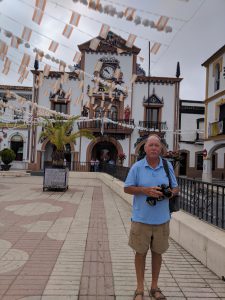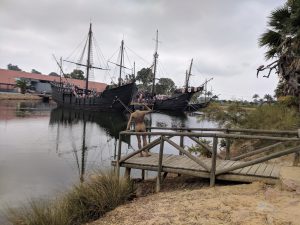The last two weeks, since Sonia returned to Bordeaux on July 4, have seen us slowly move south towards Gibraltar. We had not intended to spend as much time in Faro/Culatra but starter motor issues dictated otherwise. In between visiting the only boatyard in Faro and having the mechanic visit us at anchor in Culatra, we managed to explore Faro and Olhau; both accessible by ferry. Faro had character and some interesting architecture, but Olhau is primarily a Spanish tourist town with lots of restaurants and a nice marina. However, both Faro and Olhau marinas are only accessible via tortuous routes through the mud flats.

Once the starter motor had supposedly been fixed we headed for Mazagon. The marina there, part of string of government-owned marinas, was vast, but amazingly empty (see photo at top). Mazagon itself is very much a Spanish resort, with few English speakers. A short bus trip took us along the coast to Palos de la Frontera and la Rabida. The architecture in Palos was energizing, helped by all the bunting strung across the narrow streets. The two towns’ claim to fame is that Columbus obtained funding, at least one of the three boats, most of his crew, and blessing from the la Rabida monastery monks for his first, of four, voyages across the Atlantic, discovering America. Reviewing his charts, he never actually set foot in north America, spending most of his time exploring the Caribbean, Cuba, Hispaniola, Bahamas, and one hop to south America.

Over tapas, shared with a Brit single-hander and England soccer supporter, at a local Mazagon restaurant we heard that England lost to Croatia, a pity. Why are these guys paid so much??
A mixed motoring and sailing passage took us to our next stop at Rota marina, across the bay from Cadiz. The history of Cadiz is fascinating, one the oldest cities in Europe. The Roman amphitheater was only rediscovered and partially uncovered in the early 1980s; an interesting museum now. The town is primarily pedestrian as the cobbled streets are so narrow. The cathedral, which took over 100 years to complete dominated a large square. Many of the houses have towers, about 160 still exist, which were used as early lookouts for trading ships entering the harbor. We visited Tavira tower, the tallest in Cadiz, which also housed a camera obscura exhibit. Cadiz is definitely worth a visit, with one of the oldest covered markets as vibrant as ever, still mainly Spanish tourists, although two cruise ships were also docked there on our second trip into the city.
Our passage south was delayed by a day because we again had starter motor issues. The marina office called a bilingual mechanic who, after review took it to a friends workshop. There it was overhauled and now appears to be functioning properly (starting the engine and not blowing a 150A fuse in the starter battery circuit). The mechanic was a very friendly guy, who liked to practice his english, and gave us lots of hints do’s and dont’s regarding Morocco.
This morning, Thursday July 19, we departed Rota for Barbate, the last marina before Gibraltar bay. The 40nm passage will be spent primarily motoring as the wind is on the nose. We should reach Gibraltar over the weekend, where we are planning to stay for about 5-7 days; sightseeing and boat maintenance. Then we are off to Morocco!

3 Comments
Jonathan
Fascinating stuff!! We stayed in Mazagon – in our last outing as a duo – precisely *because* it was a Spanish resort. And hence v empty during the week. Have fun in Gib – which was visited a while back by a boat even bigger than yours!
Jenny
Happy sailing! Lovely weather here so I hope it is for you, if a bit hotter.
Ruth and Nick Pearman
Interesting ports of call. Thanks for writing it all up. Really hope the starter motor issues are behind you now and that you have a fab time in Gibraltar over the next few days. Rx